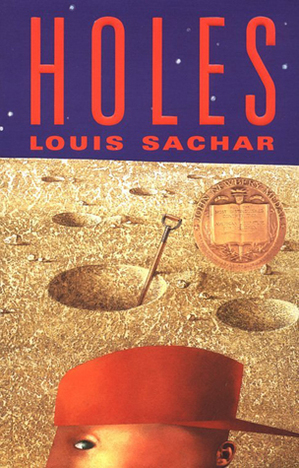
“A lot of people don’t believe in curses. A lot of people don’t believe in yellow-spotted lizards either, but if one bites you, it doesn’t make a difference whether you believe in it or not” (Sachar, 1998, p. 41).
You’ll probably be shocked to learn this, but I’d actually never read Holes before picking it up this week. I remember seeing (and loving) the movie adaptation when it came out, but I’d never bothered to sit down and read the book… Until now. Generally, I prefer to read a book before I see the movie (so as not to taint my reading experience), but when this movie came out, I hadn’t established that rule for myself just yet. After reading the book, however, I’m very glad I did, as the movie adaptation is a rare example of a film that follows the source material almost exactly. That being said, the book is absolutely wonderful, and completely deserving of its Newbery Medal.
By now, I’m sure everyone knows the premise of this particular book, but I’ll share it here in case you either need a refresher or have waited to read it like me. Holes follows the story of a boy named Stanley Yelnats, whose family has been plagued for decades by extremely bad luck. Supposedly, his great-great grandfather was cursed by a one-legged gypsy after stealing one of her pigs, leaving his descendants with never-ending misfortune. Because of this, Stanley isn’t surprised when he is wrongfully accused of stealing a pair of sneakers (which, according to him, fell out of the sky and into his hands). Given the choice between jail time and a camp known as Camp Green Lake, Stanley chooses camp… Only to discover that the “camp” is fate much worse than imprisonment. Once there, Stanley learns that his only purpose is to dig one hole (five feet deep and five feet across in every direction) every single day. While the Warden and counselors insist this is only to “build character,” Stanley and his new-found friends soon discover a mystery of buried treasure that is a century old.
One of my favorite things about this book was it’s ability to portray racism and race relations in a very real and accessible way. Because this is children’s literature, and not young adult or adult literature, the topic needs to be handled more sensitively than it would be in the latter two formats. And, much like Jacqueline Woodson’s Stella By Starlight, Holes does not shy away from the topic of race. While it is not a prominent theme in the book, there is an element of historical fiction in the snippets of Kate Barlow’s past. In these flashbacks, an innocent African American man is killed simply for kissing a white woman, while there are no consequences for the white men who attempt to force themselves on her throughout the novel. This historical observation, though a small part of the book, is still very relevant in today’s society, where a white man can get away with sexual assault while a black man will spend years in jail for non-violent offenses. This book is one of many that can hopefully start a dialogue with children about racial issues in a safe and approachable way. Perhaps the best quote on this issue from the novel comes on page 84, when Stanley is reflecting on the racial dynamic of the camp: “On the lake they were all the same reddish brown color – the color of dirt” (Sachar, 1998). In this setting, all of the boys in the camp are on equal ground; no one race is elevated above another. Though the boys occasionally fight with and tease one another, in the end they are a united force of friends, simply trying to get through the same miserable situation intact. This is a simple, yet excellent message for a children’s book to convey, and I think it’s part of the reason it’s so well-loved.
This isn’t the only reason, of course. Holes is, to put it simply, just an immensely entertaining book. It has everything a reluctant reader might want: mystery, adventure, buried treasure, gypsies, curses, intrigue, friendship, cool inventions, bandits, and a band of lovable and eclectic characters to get to know. Even if this book had no deep messages about race, friendship, family, and self-esteem (which it absolutely does), I think this book would succeed simply because it’s so entertaining. It’s just a fun, easy book to read, and one that I could see both girls and boys enjoying due to the universal nature of the story. The main characters might be boys, but the lessons learned and friendships formed are relatable to any gender. It also has a movie tie-in, making it an easy book to teach and discuss in multiple formats. It’s just a delightful little book, and one that I wish I’d read when I was younger. I’m glad that I finally sat down and gave it a chance. If you like the movie, you will most definitely enjoy the book!
Reference:
Sachar, L. (1998). Holes. New York: Farrar, Straus and Giroux.